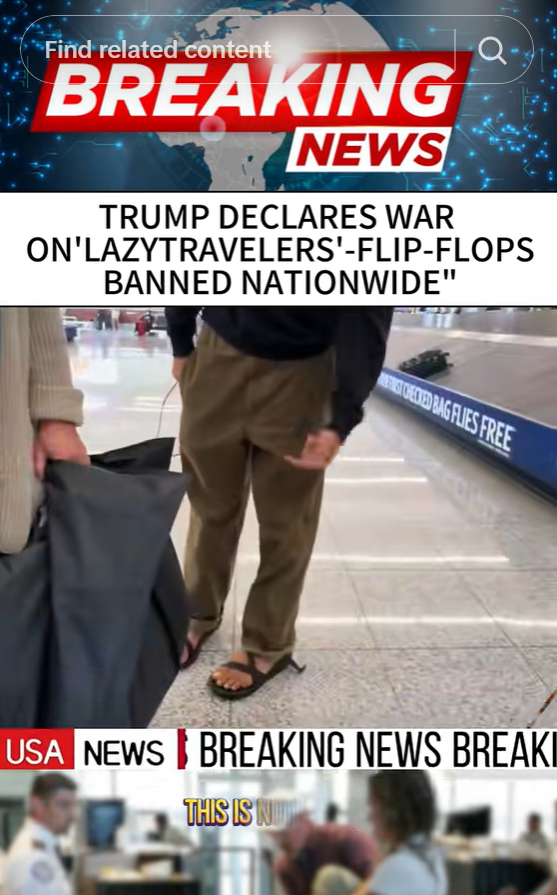In a move that left travelers, podiatrists, and beachgoers alike in disbelief, former President Donald J. Trump announced on Friday what he called a “bold crusade to restore dignity to America’s airports,” declaring war on what he described as the “epidemic of lazy travelers in flip-flops.”
Speaking at a hastily organized press conference at Reagan National Airport, Trump unveiled what he termed the “Footwear Freedom and Fashion Act,” a sweeping federal proposal that would ban flip-flops, slides, and “all flimsy, floppy footwear” from public airports and federal facilities nationwide.
“You walk through any airport, and it’s a disaster,” Trump said, gesturing emphatically. “People shuffling around in flip-flops, showing toes—terrible toes, by the way, not the best toes—completely unprofessional. America used to travel in style. Now it looks like a beach party gone wrong.”
The Ban Heard Around the Beaches
Under the proposed legislation, travelers caught wearing flip-flops at TSA checkpoints could face fines up to $250 and be required to purchase “acceptable footwear” from vending machines that will, according to the Trump campaign, sell “patriotically made, leather-strong American shoes.”
The announcement immediately sent shockwaves through the travel industry. Major footwear retailers scrambled to respond, with stock prices for several sandal brands dipping sharply within hours. Meanwhile, airport retailers reported a surge in sales of sneakers and loafers.
“This is the most foot-related panic I’ve seen since Crocs went mainstream,” said Dr. Sandra Hill, a footwear market analyst. “If this continues, we could be looking at a full-blown sandal recession.”
Public Reaction and Social Media Outrage
The response online was instantaneous. The hashtag #FlipFlopFreedom began trending within minutes, with travelers posting photos of their favorite beach sandals in defiance. Some vowed to “walk barefoot before bowing to tyranny.”
“My feet have rights,” wrote one user.
“This is the hill—or beach—I’m willing to die on.”
Not everyone disagreed with the former president’s stance.
Airport employees, including TSA officers, expressed cautious approval.
“Honestly, flip-flops slow down the line,” said one anonymous TSA worker. “People always take forever to take them off, then they lose one, then they hop around on one foot—it’s chaos.”
Experts Question Enforceability
Legal experts were quick to point out that enforcing a national footwear ban could prove complicated. Constitutional scholars debated whether such a measure might infringe upon personal freedoms guaranteed by the First Amendment—or at least the Eighth, in the case of foot comfort.
“There’s no legal precedent for banning a shoe,” said Professor Lionel Garvey of Georgetown University. “But then again, there’s no precedent for most of the last ten years.”
Civil rights groups announced plans to challenge the proposal in court, while travel bloggers began publishing “Top 10 Loafer-Friendly Destinations” in anticipation of the new travel era.
An Economic Ripple (or Toeprint)
In Florida, where flip-flops are as common as sunscreen, local businesses voiced alarm.
“We might have to pivot to ankle boots,” said Lara Jiménez, owner of Sunset Sandals in Miami Beach. “That or start exporting everything to countries that still believe in freedom between the toes.”
Meanwhile, the American Footwear Association released a statement calling the proposed ban “a direct attack on summer” and “an existential threat to open-toed comfort.”
Trump Doubles Down
When asked if the policy might alienate beachgoers or coastal voters, Trump brushed off the concern.
“People love it,” he said. “They say, ‘Sir, thank you for saving us from the noise—the slap-slap-slap on the airport floors.’ Nobody likes that sound. It’s embarrassing for our nation.”
Trump then hinted at additional “quality-of-life reforms,” including potential bans on neck pillows, pajama pants, and “airport sushi that doesn’t look American enough.”
Looking Ahead
Political analysts remain divided over whether the “Flip-Flop Ban” will gain traction in Congress, but one thing is certain: the debate has left Americans on their toes—literally.
As travelers across the nation slip reluctantly into sneakers and loafers, one question lingers in the air:
Has the era of casual travel comfort come to an end, or will the American people rise again to reclaim their right to flop freely?
For now, airports are quiet—save for the soft, squeaky chorus of rubber soles reluctantly silenced.
